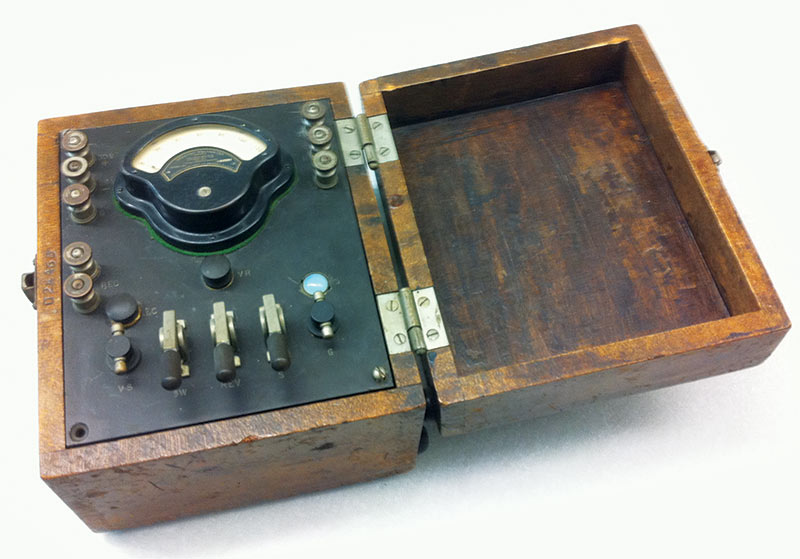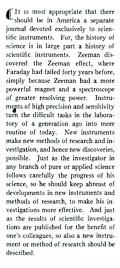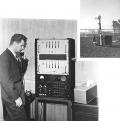Physics Instruments Now & Then
Fall
2019
Feature
Physics Instruments Now & Then
Kendra Redmond, Editor
New instruments
open doors and trigger creativity.
—Dick Peterson
 As physicists push the boundaries of understanding, the citations in their research papers reveal the mountain of knowledge on which new work is built. What may be less considered is the role of instrumentation in the discovery process. Yet digging deeper, looking further, and seeing in greater resolution than ever before requires equipment that’s up to the challenge. In this section, two experts share some of the changes they’ve observed on the job. Their responses to questions from Radiations have been edited slightly for length and clarity.
As physicists push the boundaries of understanding, the citations in their research papers reveal the mountain of knowledge on which new work is built. What may be less considered is the role of instrumentation in the discovery process. Yet digging deeper, looking further, and seeing in greater resolution than ever before requires equipment that’s up to the challenge. In this section, two experts share some of the changes they’ve observed on the job. Their responses to questions from Radiations have been edited slightly for length and clarity.
Dick Peterson: Reflections on the Evolution of Optical Tools
Peterson is a physics professor emeritus at Bethel University, long-time worker in applied optics, and a passionate builder of apparatus for teaching physics. He was a leader in the formation of the Advanced Laboratory Physics Association (ALPhA), past president of the AAPT, and winner of the APS award for research with undergraduates. In 2017 he received the APS Jonathan F. Reichert and Barbara Wolff-Reichert Award for Excellence in Advanced Laboratory Instruction.
1. When you consider the field of optics, what strikes you most about how key instruments have evolved over time?
Since I was introduced to the challenges of optical measurements in my student days of the 1960s, I can’t help but first reflect on the impact of gas and solid-state lasers. For example, while doing “pre-laser” optics we championed the coherence length of a low-pressure Hg-198 lamp source for doing interferometry. Physical optics metrology has been totally revolutionized if one compares the mercury lamp coherence length (a few centimeters) to that of the now common stabilized, single-mode He-Ne lasers found in many undergraduate labs (hundreds of meters, or even more). Of course, modern LIGO-level research systems can extend that coherence and stability by additional factors of thousands.
2. Do any other tools stand out as interesting examples of this evolution?
The acousto-optic modulator (AOM). It has always been possible to shift the frequency of light waves as they interact with matter (e.g., Doppler shifts). I recall building a cumbersome moving mirror system to shift light frequencies for heterodyne interferometry around 1970. However, the AOM became a low-cost and easily implemented way to change the frequency, intensity, and phase of light waves. Now optics tables around the world have multiple AOMs for varying applications—including laser cooling systems. I think few of us anticipated how widespread AOM applications would be. Their simplicity and modest cost make them a powerful tool in undergraduate advanced lab projects.
3. How do you view the relationship between research, instruments, and the researcher?
New instruments open doors, trigger creativity, and add to the fun. An experimentalist typically opens a fresh issue of a journal like Review of Scientific Instruments anxious to see if some new tool may broaden the perspectives of their work or (equally important) simply do it better and faster. Decades ago, I had a wonderful postdoc mentor at Los Alamos, Franz Jahoda, who was known for jumping on any new idea or optical gadget from a journal or conference and cleverly employing it the next week in his plasma diagnostics labs. I can still feel his intense (and competitive) experimental focus following such stimulation!
Bert Coursey: Reflections on the Evolution of Nuclear Radiation Equipment
Coursey is a guest researcher in the Standards Coordination Office at the National Institute for Standards and Technology (NIST) and a former editor in chief of the journal Applied Radiation and Isotopes. He is an expert in radioactivity and radiation measurements and has spent 47 years at NIST, nine of them on detail as the director of standards of the Department of Homeland Security.
1. When you consider the history of work in nuclear radiation, what strikes you most about how key instruments have evolved over time?
Modern nuclear instrumentation systems were developed in the mid-20th century for three different applications: diagnostic detection systems for nuclear weapons programs, measurement and control systems for commercial nuclear power stations, and data acquisition systems for high-energy particle accelerators. The central components of these systems are radiation detection instrumentation—ranging from Geiger-Muller counters to solid-state detectors—and analog and digital electronics systems for recording and processing signals from radiation detectors.
It clearly made much sense to develop standard detectors, electronics, and data acquisition protocols such that manufacturers could provide nuclear instrumentation components as reliable, off-the-shelf products that met the purposes of these three communities. The IEEE American National Standards Institute (ANSI) Nuclear Instrumentation Committee N42, under the leadership of Louis Costrell at NIST, stepped up to this challenge in the United States. They also provided the leadership in the IEC (International Electrotechnical Commission) Technical Committee TC 45 on nuclear instrumentation.
Radiation detection instruments have benefitted from major advances in physics: first the introduction of inorganic scintillation detectors in the 1960s and then the advent of solid-state detectors (germanium, cesium iodide, etc.) in the 1970s to 1990s. Since 2001 there have been major advances in neutron detectors driven by the needs in homeland security.
2. Are there any tools in the field that you find especially interesting in light of this topic?
Major changes in instrumentation came with the IEEE leadership in standard instrumentation modules. The Nuclear Instrument Module (NIM) bins provide a platform with a power supply that accepts standard components, including preamplifiers, amplifiers, and analog-to-digital converters. USB and other newer interfaces have aided the transition away from custom-built electronics. With advances in computational power, the radiation pulse data acquired is rapidly processed and presented as a gamma-ray radiation spectrum. With an onboard library of gamma-ray spectra, the instrument displays diagnostic information about the source.
3. How do you view the relationship between research, instrumentation and equipment, and the researcher in the field of radiation measurements?
Researchers in these fields use nuclear instrumentation as a tool to interpret radiation interactions with matter. It is not cost effective or productive for them to design the basic instrumentation modules, interfaces, and display systems that they need for their jobs. This gap is filled by fundamental research in radiation physics that leads to new radiation sensors and by the dedicated professional engineers of the IEEE and IEC committees that agree on standard packages and protocols to meet universal needs.
Send us a note with your thoughts on how physics instrumentation has changed over time at sps [at] aip.org.






